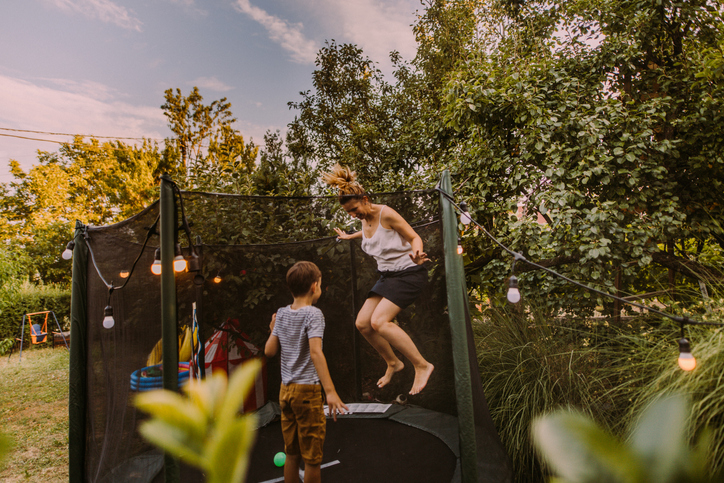 Some of my fondest childhood memories revolve around my neighbor’s trampoline. It was an unsafe, wide open, enormous monstrosity of a trampoline. There was no net (this was the 60s after all), the springs were exposed and really good at snagging errant body parts, and it was conveniently located right next to a 5 foot wall that we’d jump from. I mean, how could you not? It was right there.
Some of my fondest childhood memories revolve around my neighbor’s trampoline. It was an unsafe, wide open, enormous monstrosity of a trampoline. There was no net (this was the 60s after all), the springs were exposed and really good at snagging errant body parts, and it was conveniently located right next to a 5 foot wall that we’d jump from. I mean, how could you not? It was right there.
You’d bounce for hours, you’d bounce till your calves were on fire. You’d spend hours trying to perfect the front flip, and then the back flip. You’d have death matches where you and another guy would fly at each other from opposite ends of the trampoline, colliding in mid air and trying to knock the other on his back. We called it jousting.
Thankfully, there were no catastrophic injuries. No concussions, no hyperextended knees, no torn ligaments. I can’t even recall a broken bone.
But never did we imagine the trampoline as a way to “exercise.” It was a place to play.
Turns out that, just like all the other fun stuff you do as kids like run around, wrestle, climb, ride bikes, jump, play games and sports, swim, and throw things, trampolining has become a legitimate form of exercise. Search Youtube and you’ll find hundreds of full-blown exercise routines and regimens using the trampoline. They call it “rebounding,” and it usually involves a small personal-sized trampoline, but it’s essentially bouncing on a trampoline.
Benefits of Trampoline Training and Rebounding
What are the benefits of trampoline training or rebounding?
Cardiovascular Fitness
In asthmatic patients, rebounding on a trampoline was compared to typical aerobic training. Both interventions improved fitness and cardiovascular health, but rebounding was even more effective, increasing exercise capacity (VO2max) and lung exhalation and inhalation capacity to a greater degree.1
Low Intensity Enough for Everyone
Although all forms of exercise can be tailored to the individual’s capacity, some forms work better than others. You’re not going to have the 72 year old obese heart attack survivor doing high intensity CrossFit WODs. You’re not going to put the frail grandma on a heavy deadlift program. You might be able to work those populations up to more intense stuff, but you have to be careful and move slowly.
Rebounding on a trampoline offers a low-barrier to entry for almost everyone. It’s easy on the joints. It has “give.” It’s inviting. Some trampolines even have support posts you can hold onto until your balance catches up. You can put grandma or the heart attack survivor with bad knees on a trampoline and have them bounce in place. Their feet don’t even have to leave the ground and they’ll still derive benefit.
For instance, in older women with low bone density, a trampoline program helped them improve balance, strength, gait, and mobility. It reduced their fear of falling in every day life—they felt more stable overall. That’s no small feat.2
Tissue Suppleness and Pliability
I’m a big believer in “like for like.” If you have liver issues, maybe you need some liver high in folate and choline. If you have joint issues, eat more collagen or bone broth made from animal joints. And if your tissues are stiff and non-compliant, perhaps bouncing on a supple, pliable surface with lots of give and tons of “flow” and “bounce” will help your tissues become more flowing, supple, and pliable.
In patients with diabetic neuropathy of the foot, rebounding on a mini-trampoline “wakes up” the foot, improving foot mobility, plantar pressure, and sensation.3
Improved Metabolic Health
Trampolining or rebounding is exercise, and exercise improves metabolic health. What this goes to show is that you don’t have to grind it out on a treadmill while cable news blares at you. You can do what most people find to be pleasant and enjoyable and downright fun, like bouncing on a trampoline for 30 minutes three times a week, and see improvements in your lipid numbers, blood glucose control, insulin sensitivity, and waist circumference—even if you have type 2 diabetes.4 Even if you’re a type 2 diabetic in rural Nigeria.5
Even if you have normal glucose control, a short session on the trampoline is an effective way to reduce blood sugar levels.6 A rebounding session could replace the “after meal walk for better blood sugar.”
Lymph Flow
Lymphatic fluid is the medium by which the body clears out waste, immune cells, toxins, and other unwanted ephemera. Its passive flow is relatively subtle, or even weak. To really clear lymph fluid, you need to move. Muscle contractions clear lymph fluid. Walking clears it. You know how sometimes you’ll see those Chinese grandmas walking in the park, swinging their arms, clapping themselves on the chest and shoulders? That’s a great way to stimulate the flow of lymphatic fluid through the body.
Another great way to do it is to bounce on a trampoline. Better yet, bounce on the trampoline and let your arms bounce around as they see fit. Do not control them. Let them go where they will.
Wakefulness
We have a small trampoline my wife loves to use. While I don’t really go on it for “exercise,” (I prefer full size trampolines, personally) I do like to use it to quickly energize myself. It’s a decent stand-in for my slackline, which I used to have up in the backyard in Malibu. If I ever hit a lull in the day, or felt “writer’s block” creeping up on me, I’d spend five to ten minutes on the slackline and be instantly energized and ready to go. The same thing happens with the trampoline. I bounce around for five to ten minutes and feel fantastic.
To really wake up and get moving, try breathing in, exhaling, holding your breath, and then bouncing on the trampoline until you get the urge to breathe. Best little energizer I’ve discovered as of late.
Calf Training
The problem with calf raises is you have to do them for hundreds of reps almost every day to see any results; the calves are notorious workhorses that can take a ton of punishment before changing or growing. That gets boring—at least to me. One of the most enjoyable ways to train your calves is to bounce on a trampoline, ideally a large one with your kids or grandkids (yeah, yeah, bouncing with kids can be dangerous, so be smart about it; this isn’t medical advice, by the way). You’ll be having so much fun that you don’t realize your calves are on fire.
There are few calf workouts as effective as a trampoline.
It’s Fun
You guys know this about me: I value play and sheer enjoyment of life as a virtue. In addition to creating a legacy and following a mission, enjoying the bounties of this plane of existence are why we exist. Fun is an intrinsic good. It justifies itself. That you get a great workout and improve your metabolic health, balance, tissue pliability, and calf and waist circumference are nice, too, of course.
Proper Rebounding
Despite the playful nature of rebounding and bouncing on a trampoline, there are tips and queues to keep in mind.
Stay upright when you bounce.
Don’t bounce hunched over at the lower back or breaking at the hips. This is not like jumping on flat, stable ground, where you absorb the impact with your glutes and hamstrings. On the trampoline, the surface absorbs the impact. Stay upright with extended hips and your tissues stacked on top of each other.
Go with the flow—don’t fight the trampoline.
People get injured when they try to fight against the trampoline. Instead of actually using the rebounding effect of the trampoline, they try to land on the trampoline like it was the ground and absorb the impact. Bad idea. Jump, land, and jump again as the trampoline throws you upward. Continue. It’s “rebound,” remember? Re-bound.
If you’re getting nervous because you’re jumping too high, just gradually decrease the height you jump. It’s much safer than stopping the bounce entirely.
Always center yourself.
Don’t let the bounce get away from you. Be deliberate about where you land and in which direction you’re going. Don’t land with your feet way out in front or in back of your center of gravity. That’s the stuff hyperextended knees are made of. Maintain that continuity along your body.
Vary your bounces.
You can simply bounce straight up and down, but I’d recommend you’ll get more out of the experience if you try different styles of bounces.
Bounce from left to right.
Do 180s and 360s.
Try a flip or two if you’re confident you can stick it.
Do jumping jacks.
Try single leg bounces.
Try just bouncing without even leaving the trampoline. It’s more of a “pump” action, and great on the quads.
Get creative and as long as you stay true to the three previous tips, you’ll be okay.
Pushups.
This is the hidden secret of the trampoline. Do pushups on it. Normal, everyday pushups become incredibly difficult on a trampoline. It’s not a bounce but I had to mention it.
That’s it for today, folks. Have you ever used a trampoline? Would you? Give these a shot and let me know what you think.
Take care, everyone.
The post The Benefits of Trampolining and Rebounding appeared first on Mark's Daily Apple.





